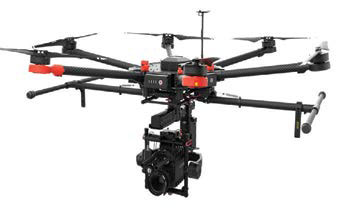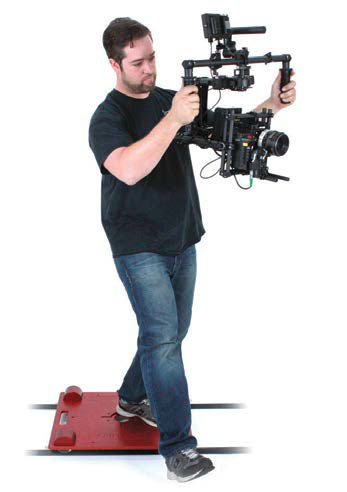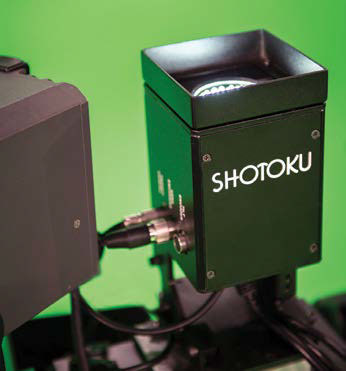2016 NAB Product Review: Camera Support
Camera support equipment at the NAB Show was dominated by drone companies of all sizes. Where last year there was one large, netted enclosure the unmanned aircraft vendors had to share for their demos, this year most drone exhibitors had their own, smallish enclosures to demo their wares. One multi-rotor craft was witnessed tangling with its enclosure, beating itself to death before falling and smashing itself to pieces. The buzz is that this wasn’t a singular happening.

3DR SoloDRONES
3DR showed three flight modes for Solo. In one, the pilot completely controls the drone. In a second mode, the pilot preplans the flight parameters and then lets the drone fly it by itself. In the third mode, the drone flies a preplanned path, but the camera operator controls pan, tilt, zoom and framing. The operator can override the aircraft in the second or third mode at any time. The company also debuted augmented reality in which a software app overlays visuals in real time on a user’s mobile screen.
Autel showed off its X-Star Premium, a quad-copter designed for aerial imagery. The 4K camera and removable 3-axis gimbal allows users to shoot UHD or 12MP photos with HD Live View from up to 1.2 miles away. It boasts an intelligent flight control system, dual GPS and GLONASS satellite navigation aided by the Starpoint Positioning System.

DJI Matrice 600DJI premiered its Matrice 600 drone, a new flying platform designed for professional aerial photography and industrial applications. It is built to closely integrate with DJI technologies, including the A3 flight controller, Lightbridge 2 transmission system, Intelligent Batteries and Battery Management system.
Freefly Systems debuted ALTA 8, derived from the company’s ALTA 6 drone. It is designed for the most demanding customers who want to carry the largest cinema payloads. It easily unpacks and can be ready to shoot in under five minutes. Payloads weighing up to 20 pounds can be carried.
GDU showcased its Byrd drone, designed for portability. The arms, propellers and landing gear all collapse into an iPad-sized package. Its universal platform allows endless combinations, providing a way to quickly swap out the gimbal and camera. Safety features keep the aircraft close by.
Yuneec flew its Typhoon H aerial photography and videography platform, with flight durations of up to 25 minutes. It utilizes a CGC3+ 4K UHD camera, and has an Android-powered ST16 Ground Station that features a 7-inch touchscreen that displays live footage of the flight in 720p.
The professional video industry's #1 source for news, trends and product and tech information. Sign up below.
TRIPODS & FLUID HEADS
Cartoni introduced four new fluid heads, the FOCUS 8, FOCUS 12, FOCUS 18 and FOCUS 22, designed to accommodate camera packages from zero to 48.50 pounds. They incorporate Cartoni’s counterbalance system for superb performance.
Davis & Sanford added to its Provista video family of tripods with the ProvistaGRi, a tripod and head designed for quick setup and breakdown. The three-section single aluminum tripod features quick release leg locks that are easy to use even in cold weather.
Libec introduced a pair of new fluid heads in its ALLEX line, the RH25D Dual Head (13 pound payload), and the RH45D Dual Head (26.5 pound payload). Both heads come equipped with a 75mm and flat base adapter. A major feature on the RH25D and RH45D is a continuous counter balance.

Sachtler Video 18 S2 Fluid HeadMiller introduced a new counterbalancing system in its arrowxSeries fluid heads. The 16 CB PLUS sequential counterbalance provides eight large counterbalance steps, then a finer half-step adjustment, allowing the operator to quickly make a rough setting of counterbalance, then finely tune it for optimum setup.
Sachtler has beefed up its Video 18 tripod system, adding over 8 pounds to the payload of the new Video 18 S2. It can handle a fullsize ENG camera up to 44.1 pounds and provides a smooth drag adjustment via a stepped mechanism that is repeatable and fast.

Matthews Dutti DollyDOLLIES & SLIDERS
Camera Goat demonstrated its affordable dolly track system, designed to handle a range of cameras from GoPros to REDs and Alexas. It can be quickly set up by a single shooter, and is solidly built from aluminum. The track is easily adjustable over even the most uneven ground.
Matthews unveiled its Dutti Dolly, a lowprofile dolly that rides a 3/16-angle aluminum rail as well as round track. Machined out of a single piece of metal, it features a built-in Mitchell mount and several other accessory threads.
Red Rock Micro demonstrated its One Man Crew Director motorized parabolic slider, designed to transform static shots with cinematic motion without a dedicated operator. One Man Crew Director is useful for animating B-roll, inserts and reveals to replace static shots.
CAMERA RIGS AND STABILIZERS
Chrosziel demonstrated its LWS 401-FS7 Light Weight Support for Shoulder Mounting Sony FS7 Cameras, which provides optimum balance for the camera when shoulder mounted. The new baseplate features a slim design with a sturdy and ergonomic shoulder pad.
Cool-Lux demonstrated its range of four camera rigs. Each rig includes the Cool-Lux SHIFT Baseplate, which features a flip-out tripod mount that acts as a chest pad in shoulder rig mode. The baseplate is fully adjustable to work with any camera.
Freefly Systems’ news on its MoVI line of stabilizers was a new Akira 5.0 firmware update. Features include HiPer, which improves stabilization up to 50-percent, opening up opportunities to use longer focal lengths without sacrificing stability. Also notable was the all-new Timelapse Mode, that allows for completely programmable camera moves.

Glidecam XR-Pro StabilizerGlidecam debuted its XR-Pro stabilizer, designed to handle camera payloads of up to 10 pounds. To provide important mass to help stabilize lightweight cameras, it incorporates four steel weight plates. The XR-Pro is engineered for fast setup and deployment.
Steadicam rolled out its A Series of stabilizers, a replacement for their Pilot stabilization system. There are models to handle three different capacities. Also in the booth was the Steadicam M-1, with a modular design to allow user-configuration without tools.
ROBOTIC CAMERA SYSTEMS
RUSHWORKS introduced its PTX Universal PanTilt head, designed to work with the Blackmagic Design Micro Studio Camera 4K and other standalone cameras and camcorders from Sony, Canon, Panasonic and JVC that support LANC control.

Shotoku Free-d2 for VR/ARShotoku unveiled the Free-d2 VR/AR a new-generation tracking system that does not require physical encoder devices attached to the camera support’s moving axes. The system uses advanced video processing algorithms and simple ceiling markers to precisely determine the exact position and orientation.
Telemetrics realized its workhorse remote pan and tilt head was “getting long in the tooth,” and engineered its replacement, the IP-controlled PT-LP-55, featuring remote diagnostics and the ability to interface with digital lens controls.
Vinten demonstrated its new Hexagon track system which features a unique hexagon rail shape and robust dolly design for demanding environments. Track can be laid for a distance of over 150 feet, and the system has an integral cable management system.
TELEPROMPTERS
Autoscript introduced a range of prompting solutions for the Apple iPad Pro, including options for the 9.7- and 12.9-inch versions. It includes Mac and PC QStart software, allowing the iPad Pro to be used in a traditional teleprompter workflow.
CueScript premiered the CSF10, a lightweight yet fully featured prompting system designed for use with jibs and cranes. It can be used with a collapsible hood and prompter glass or as a straight reading system and features a 2000-nit screen that is easy to read in sunlight. The company also debuted CueiT prompting software which includes Ribbon menu style, Quick commands and features that can be accessed from multiple locations, markers to enable operators to create their own sub-run order and pinpoint positions to instantly navigate within the script, either on their edit screen and/or the prompt output and no separate configuration menu.
Mirror Image showcased its LC-120, a 12-inch LCD prompter that accepts HDMI, SDI, VGA and Composite inputs. It provides 1000 nits of brightness for daylight use, something they point out an iPad cannot do.
ProPrompter demonstrated its PRO3 studio kit, featuring a universal tray for iPad Pro and other tablets. It fits DSLR, consumer and ENG cameras, and employs an extra-wide 6-/40 studio quality beam splitter glass. Its foldable design provides for portability and easy storage.
Telescript exhibited its Robotic Prompting Systems, designed specifically for mounting on robotic cameras. The two-piece system makes it easier to achieve balance by moving the electronics module behind the camera. The Robotic Prompter and all Telescript monitors accept SDI, HDMI, VGA, component, and NTSC and PAL composite input.
